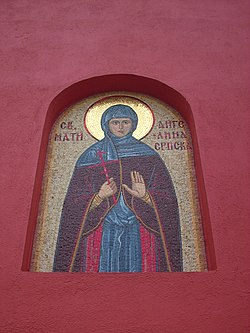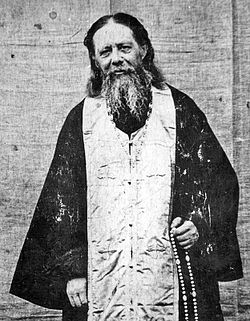Top Qs
Timeline
Chat
Perspective
July 30 (Eastern Orthodox liturgics)
From Wikipedia, the free encyclopedia
Remove ads
July 29 - Eastern Orthodox Church calendar - July 31

All fixed commemorations below are celebrated on August 12 by Old Calendar.[note 1]
For July 30th, Orthodox Churches on the Old Calendar commemorate the Saints listed on July 17.
Saints
- Apostles of the Seventy Silas and Silvanus, and with them Apostles Crescens, Epenetus, and Andronicus (1st century)[1][2][3][4][5][note 2]
- Martyrs under Decius (c. 251):[1][6][7][8]
- Hieromartyr Polychronius, Bishop of Babylon in Egypt;
- Hieromartyrs Parmenius, Helimenas (Elimas), and Chrysotelus, Priests;
- Luke and Mocius, Deacons;
- Martyrs Maximus and Olympius.
- Martyrs Abdon and Sennen, princes of Persia, at Rome (251)[1][6][9][10][11][12][note 3][note 4]
- Hieromartyr Valentine, Bishop of Interamna (Terni) in Italy, and his martyred disciples Proculus, Ephebus, Apollonius, and Abundius (c. 273)[1][5][6][14][15] (see also: February 14, July 6)
- Martyr John the Soldier, at Tralles in Asia Minor (361-363)[1][6][16][17] (see also: July 29)
- Martyr Julitta of Caesarea in Cappadocia (4th century)[3][5][18][19][note 5]
Remove ads
Pre-Schism Western saints
- Saint Rufinus of Assisi, a martyr in one of the early persecutions in Assisi in Italy.[9][note 6]
- Saints Maxima, Donatilla and Secunda, three holy virgins (Secunda was aged twelve), martyred in Tebourba in North Africa under Diocletian (304)[5][20][note 7]
- Saint Peter Chrysologus, Archbishop of Ravenna (c. 450)[9][note 8]
- Saint Ursus of Auxerre, a hermit at the church of St Amator in Auxerre in France, who was made bishop of that city when he was aged seventy-five (508)[9][note 9]
- Saint Ermengyth, a sister of St Ermenburgh, she lived as a nun at Minster-in-Thanet in England (c. 680)[9][21]
- Saint Tatwine, the tenth Archbishop of Canterbury (734)[9][21][22][note 10]
- Martyr-King Olaf II Haraldsson, Enlightener of Norway (1030)[9][23][24]
Remove ads
Post-Schism Orthodox saints
- Saint Stephen Vladislav of Serbia (1243)[1][6] (see also: September 24)
- Prince Tsotne Dadiani the Confessor, of Mingrelia, Georgia (13th century)[1][6][25]
- Saint Angelina (Brancovic), Despotina of Serbia (c. 1520)[1][5][6][26]
New martyrs and confessors
Other commemorations
Icon gallery
- Apsotle Epenetus of Carthage.
- Apostle Andronicus of Pannonia, with Athanasius of Christianoupolis and Junia.
- St. John the Warrior.
- St. Stephen Vladislav of Serbia.
- Martyr-King Olaf II Haraldsson, Enlightener of Norway.
- St. Tsotne Dadiani the Confessor.
- St. Angelina (Brancovic), Despotina of Serbia.
- New Hiero-confessor Anatole II (Potapov) "the Younger", Elder of Optina Monastery.
- Venerable Herman of Solovki.
- Sitka Icon of the Most Holy Theotokos.
Remove ads
Notes
- The notation Old Style or (OS) is sometimes used to indicate a date in the Julian Calendar (which is used by churches on the "Old Calendar").
The notation New Style or (NS), indicates a date in the Revised Julian calendar (which is used by churches on the "New Calendar"). - Persian nobles brought to Rome as prisoners, they devoted themselves to looking after imprisoned Christians and burying the relics of the martyrs.
- "At Caesarea, in Cappadocia, St. Julitta, martyr. As she sought to recover through the courts the restitution of goods seized by an influential personage, the latter objected that, being a Christian, her cause could not be pleaded. The judge commanded her to offer sacrifice to the idols, that she might be heard. With great firmness, she refused, and being thrown into the fire, yielded her spirit to God, though her body remained uninjured by the flames. St. Basil the Great has proclaimed her praise in an excellent eulogy."[13]
- "At Tuberbum Lucernarium, in Africa, the holy virgins and martyrs Maxima, Donatilla, and Secunda. The first two, in the persecution of Valerian and Gallienus, were forced to drink vinegar and gall, then scourged most severely, and stretched on the rack, burned on the gridiron, rubbed over with lime, afterwards exposed to the beasts with the virgin Secunda, twelve years old, but being untouched by them, they were finally beheaded."[13]
- Born in Imola in Italy, he became deacon there, and then archdeacon and Archbishop of Ravenna (c 433). He is famed for his eloquence in preaching, thus the name Chrysologus, 'Golden Speech'. Many of his sermons still exist.
- A monk at Breedon in Mercia in England who was famed for his piety and learning. He succeeded St Brithwald, becoming the tenth Archbishop of Canterbury.
- See: (in Russian) Анатолий (Потапов). Википедии. (Russian Wikipedia).
Remove ads
References
Sources
Wikiwand - on
Seamless Wikipedia browsing. On steroids.
Remove ads












